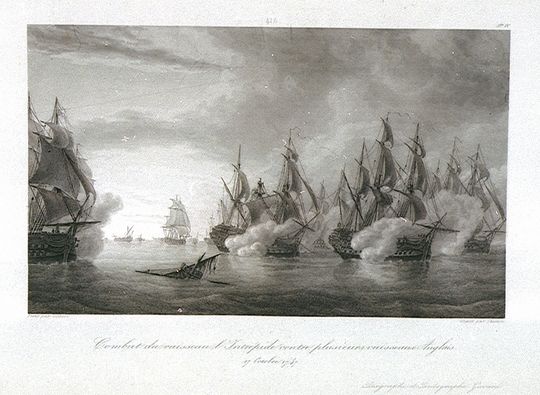|
Henry Raper (Royal Navy Officer)
Henry Raper (1767 – 5 April 1845) was a British Royal Navy admiral. Biography Raper was born in 1767, entered the navy in February 1780, on board the Berwick, which in July joined the flag of Sir George Rodney in the West Indies. Returning in 1781, he took part in the battle on the Doggerbank on 5 Aug. Raper afterwards served in the Cambridge, and in her was at the relief of Gibraltar by Lord Howe in October 1782. He then joined the Marquis de Seignelay, with Commander John Hunter, his former shipmate in the Berwick, and remained in her till 1785. From 1785 to 1788 he was in the Salisbury, the flagship of Rear-admiral John Elliot, at Newfoundland, and afterwards in the Impregnable and Queen Charlotte in the Channel till 22 November 1790, when he was promoted to the rank of lieutenant. Through 1791 he served in the Vesuvius bomb, and in October 1793 was appointed to the Queen Charlotte, flagship of Earl Howe, to whom he acted as signal lieutenant in May and on 1 June 1794. On 4 ... [...More Info...] [...Related Items...] OR: [Wikipedia] [Google] [Baidu] |
London
London is the Capital city, capital and List of urban areas in the United Kingdom, largest city of both England and the United Kingdom, with a population of in . London metropolitan area, Its wider metropolitan area is the largest in Western Europe, with a population of 14.9 million. London stands on the River Thames in southeast England, at the head of a tidal estuary down to the North Sea, and has been a major settlement for nearly 2,000 years. Its ancient core and financial centre, the City of London, was founded by the Roman Empire, Romans as Londinium and has retained its medieval boundaries. The City of Westminster, to the west of the City of London, has been the centuries-long host of Government of the United Kingdom, the national government and Parliament of the United Kingdom, parliament. London grew rapidly 19th-century London, in the 19th century, becoming the world's List of largest cities throughout history, largest city at the time. Since the 19th cen ... [...More Info...] [...Related Items...] OR: [Wikipedia] [Google] [Baidu] |
Royal Navy
The Royal Navy (RN) is the naval warfare force of the United Kingdom. It is a component of His Majesty's Naval Service, and its officers hold their commissions from the King of the United Kingdom, King. Although warships were used by Kingdom of England, English and Kingdom of Scotland, Scottish kings from the early Middle Ages, medieval period, the first major maritime engagements were fought in the Hundred Years' War against Kingdom of France, France. The modern Royal Navy traces its origins to the English Navy of the early 16th century; the oldest of the British Armed Forces, UK's armed services, it is consequently known as the Senior Service. From the early 18th century until the World War II, Second World War, it was the world's most powerful navy. The Royal Navy played a key part in establishing and defending the British Empire, and four Imperial fortress colonies and a string of imperial bases and coaling stations secured the Royal Navy's ability to assert naval superior ... [...More Info...] [...Related Items...] OR: [Wikipedia] [Google] [Baidu] |
George Rodney
Admiral (Royal Navy), Admiral George Brydges Rodney, 1st Baron Rodney, Order of the Bath, KB (baptism, bap. 13 February 1718 – 24 May 1792), was a Royal Navy officer, politician and colonial administrator. He is best known for his commands in the American War of Independence, particularly his victory over the French at the Battle of the Saintes in 1782. It is often claimed that he was the commander to have pioneered the tactic of Naval tactics in the Age of Sail#Developments during the American War of Independence, breaking the line. Rodney came from a distinguished but poor background, and went to sea at the age of fourteen. His first major action was the Second Battle of Cape Finisterre (1747), Second Battle of Cape Finisterre in 1747. He made a large amount of Prize (law), prize money during the 1740s, allowing him to purchase a large country estate and a seat in the House of Commons of Great Britain. During the Seven Years' War, Rodney was involved in a number of amphibi ... [...More Info...] [...Related Items...] OR: [Wikipedia] [Google] [Baidu] |
John Hunter (Royal Navy Officer)
Vice Admiral of the Red, Vice Admiral John Hunter (29 August 1737 – 13 March 1821) was an officer of the Royal Navy, who succeeded Arthur Phillip as the second Governor of New South Wales, serving from 1795 to 1800.J. J. Auchmuty,Hunter, John (1737–1821), ''Australian Dictionary of Biography'', Volume 1, Melbourne University Press, MUP, 1966, pp 566–572. Retrieved 12 August 2009 Both a sailor and a scholar, he explored the Parramatta River as early as 1788, and was the first to surmise that Tasmania might be an island. As governor, he tried to combat serious abuses by the military in the face of powerful local interests led by John Macarthur (wool pioneer), John MacArthur. Hunter's name is commemorated in historic locations such as Hunter Valley and Hunter Street, Sydney. Family and early life John Hunter was born in Leith, Scotland, the son of William Hunter, a captain in the merchant service, and Helen, ''née'' Drummond, daughter of J. Drummond and niece of George Drumm ... [...More Info...] [...Related Items...] OR: [Wikipedia] [Google] [Baidu] |
John Elliot (Royal Navy Officer)
Admiral John Elliot (1732 – 20 September 1808) was a Royal Navy officer and colonial administrator who served in the Seven Years' War and American War of Independence. He rose to the rank of admiral, and served briefly as the governor of Newfoundland. Elliot was born into the gentry in Scotland, and entered the navy. Little is known about his early service, but he received a promotion to post-captain during the Seven Years' War, and commanded the 32-gun frigate with distinction, first capturing a small French frigate, and then taking command of a squadron of three ships and bringing to action the notorious privateer François Thurot, who had been raiding the coast of Ireland in 1760. After a short but bitter engagement, Thurot was killed and his ships captured. Elliot was widely hailed as a hero and he and his captains received several rewards. He commanded several other ships during the remainder of the war, and after a period of unemployment during the peace, returned to ... [...More Info...] [...Related Items...] OR: [Wikipedia] [Google] [Baidu] |
Henry Raper
Henry Raper (c. 1799 – 6 January 1859) was a British Royal Naval lieutenant who became a nineteenth-century authority on navigation. Amongst his achievements was his quantification of the unreliability of a key longitudinal measurement, lunar distance, when taken at different times. One early beneficiary of Raper's research was Robert FitzRoy, whose second expedition was made famous by the work of his travelling companion, Charles Darwin. Raper is primarily remembered, however, for his seminal work ''The Practice of Navigation and Nautical Astronomy'', for which he was awarded the Founder's Medal of the Royal Geographical Society in 1841. According to his memorial at St Peter & St Paul's Church, in Dinton, Buckinghamshire, it was "a work universally adopted by the naval service". Raper died on 6 January 1859 at Torquay in Devon, England England is a Countries of the United Kingdom, country that is part of the United Kingdom. It is located on the island of Great B ... [...More Info...] [...Related Items...] OR: [Wikipedia] [Google] [Baidu] |
1767 Births
Events January–March * January 1 – The first annual volume of ''The Nautical Almanac and Astronomical Ephemeris'', produced by British Astronomer Royal Nevil Maskelyne at the Royal Observatory, Greenwich, gives navigators the means to find longitude at sea, using tables of lunar distance. * January 9 – William Tryon, governor of the Royal Colony of North Carolina, signs a contract with architect John Hawks to build Tryon Palace, a lavish Georgian style governor's mansion on the New Bern waterfront. * February 16 – On orders from head of state Pasquale Paoli of the newly independent Republic of Corsica, a contingent of about 200 Corsican soldiers begins an invasion of the small island of Capraia off of the coast of northern Italy and territory of the Republic of Genoa. By May 31, the island is conquered as its defenders surrender.George Renwick, ''Romantic Corsica: Wanderings in Napoleon's Isle'' (Charles Scribner's Sons, 1910) p230 * February 19 ... [...More Info...] [...Related Items...] OR: [Wikipedia] [Google] [Baidu] |
1845 Deaths
Events January–March * January 1 – The Philippines began reckoning Asian dates by hopping the International Date Line through skipping Tuesday, December 31, 1844. That time zone shift was a reform made by Governor–General Narciso Claveria on August 16, 1844, in order to align the local calendars in the country with the rest of Asia as trade interests with Imperial China, Dutch East Indies and neighboring countries increased, after Mexico became independent in 1821. The reform also applied to Caroline Islands, Guam, Marianas Islands, Marshall Islands, and Palau as part of the Captaincy General of the Philippines. * January 10 – Elizabeth Barrett receives a love letter from the younger poet Robert Browning; on May 20, they meet for the first time in London. She begins writing her ''Sonnets from the Portuguese''. * January 23 – The United States Congress establishes a uniform date for federal elections, which will henceforth be held on the first Tuesday after the ... [...More Info...] [...Related Items...] OR: [Wikipedia] [Google] [Baidu] |
18th-century Royal Navy Personnel
The 18th century lasted from 1 January 1701 (represented by the Roman numerals MDCCI) to 31 December 1800 (MDCCC). During the 18th century, elements of Enlightenment thinking culminated in the Atlantic Revolutions. Revolutions began to challenge the legitimacy of monarchical and aristocratic power structures. The Industrial Revolution began mid-century, leading to radical changes in human society and the environment. The European colonization of the Americas and other parts of the world intensified and associated mass migrations of people grew in size as part of the Age of Sail. During the century, slave trading expanded across the shores of the Atlantic Ocean, while declining in Russia and China. Western historians have occasionally defined the 18th century otherwise for the purposes of their work. For example, the "short" 18th century may be defined as 1715–1789, denoting the period of time between the death of Louis XIV of France and the start of the French Revoluti ... [...More Info...] [...Related Items...] OR: [Wikipedia] [Google] [Baidu] |
19th-century Royal Navy Personnel
The 19th century began on 1 January 1801 (represented by the Roman numerals MDCCCI), and ended on 31 December 1900 (MCM). It was the 9th century of the 2nd millennium. It was characterized by vast social upheaval. Slavery was Abolitionism, abolished in much of Europe and the Americas. The First Industrial Revolution, though it began in the late 18th century, expanded beyond its British homeland for the first time during the 19th century, particularly remaking the economies and societies of the Low Countries, France, the Rhineland, Northern Italy, and the Northeastern United States. A few decades later, the Second Industrial Revolution led to ever more massive urbanization and much higher levels of productivity, profit, and prosperity, a pattern that continued into the 20th century. The Catholic Church, in response to the growing influence and power of modernism, secularism and materialism, formed the First Vatican Council in the late 19th century to deal with such problems an ... [...More Info...] [...Related Items...] OR: [Wikipedia] [Google] [Baidu] |




